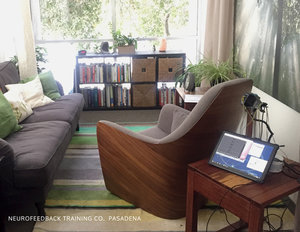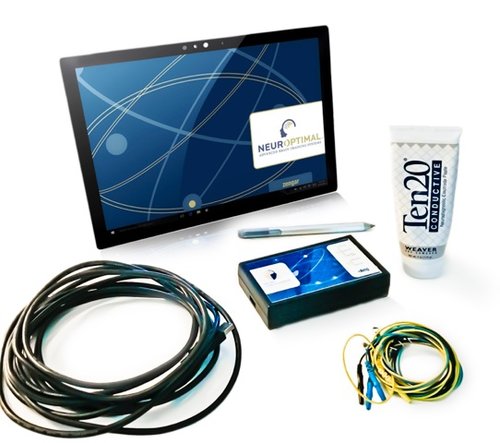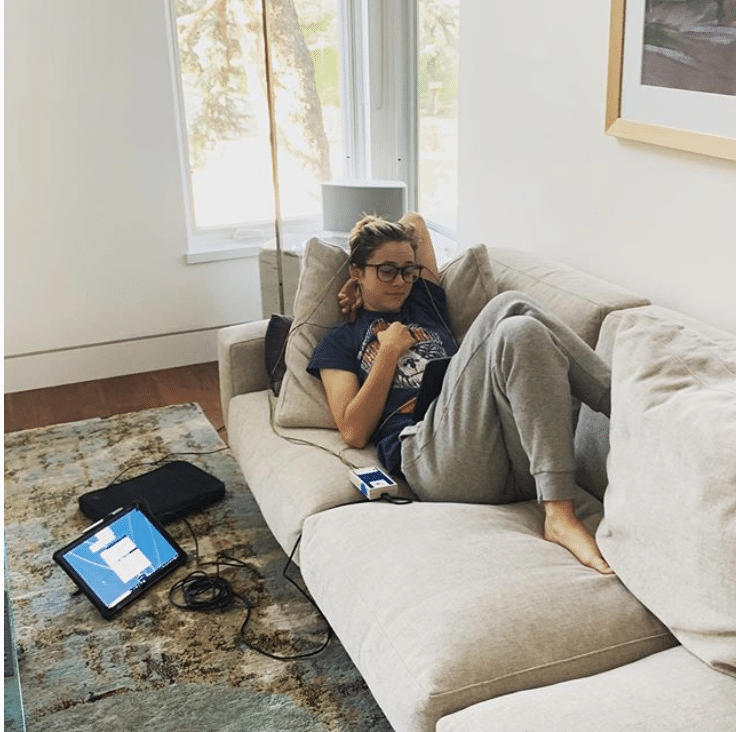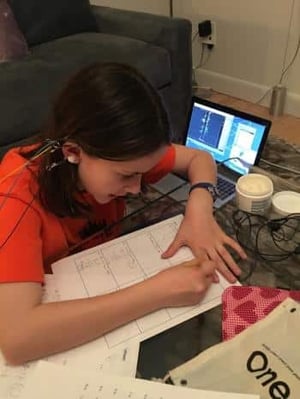Neurofeedback, or EEG biofeedback, used to only be safe and effective if administered by a health care clinician trained in setting brain frequency protocols to gently force a brainwave pattern change in the client.
This era of in-office neurofeedback as the only effective and safe chose is over.

When the speed of computing power reached that of the human brain, real-time millisecond-by-millisecond feedback for the brain became possible. This type of feedback, called Dynamical neurofeedback, became fully automated in 2010. This advancement in the technology made it so the trainee’s brain became the expert, and an outside expert trainer setting protocols was no longer needed.
NeurOptimal® neurofeedback is the only Dynamical, fully automated system that was designed with the same technology for home brain training and professional use.
This advancement means the system can be rented or purchased directly by consumers, and then used whenever you’d like, in the comfort of your own home. Because NeurOptimal® is easy to use, consumers are assured quality and consistent training, but self-administered or parents can use with their children. It adds options for consumers in terms of the cost of sessions and when they are done. T
his improvement makes it easy for you and your family to use before bed, on the weekends, or whenever you have time!
Below, we discuss how to use the neurofeedback device at home and how much it costs, and answer some frequently asked questions.
Is There A Personal Home Neurofeedback Device?

Yes. NeurOptimal® Personal System is a personal neurofeedback device, and it uses the same technology as its professional version. Most EEG biofeedback technologies are not designed for personal use at home. BrainPaint has a home-use device but it requires a trainer to oversee the training remotely. This means that although the device is technically in the home, training sessions are still limited to trainer availability.
The majority of brain training devices are first generation neurofeedback systems, which require an expert trainer to manually set protocols and give the correct feedback to the brain in order for the trainee to experience neurofeedback benefits.
Let’s use the analogy of automobile technology to understand the history of neurofeedback: the first generation of cars had a manual crank starter, then we moved to a key and now we press a button to start the car. The latest technological leap to Dynamical neurofeedback is self-driving cars.
Most recently, neurofeedback has made the leap to automation ensuring the same quality of training in every session.
What Is The Best Neurofeedback System For Home Use?

When we were testing different systems for our neurofeedback centre in New York and then Denver, we chose the NeurOptimal® neurofeedback device because of the safety of the system, the fact that clients could train at home or in-office, and the quality of the results we saw in people who had trained with NeurOptimal®.
Given the investment, clients would need to make we wanted to give them the most options.
Renting a home kit saves approximately 50% over in-office sessions, and purchasing saves up to 80%!
What are the benefits of neurofeedback home sessions?
Our most frequent renters are clients wanting support for their children, either for school performance or anxious or angry feelings connected often with stress. I see the best results when a parent also trains. When a parent finds the support for calm it makes it easier for children to manage stress and be able to focus.
Our second most frequent renters are adults looking to reset emotionally, help with sleep and stress management. And in Colorado, we get a number of clients looking to achieve peak performance states and look to neurofeedback as an important tool for achieving peak focus, calm and flow.
NEUROFEEDBACK HOME TRAINING FAQ’S
To help you explore whether a home neurofeedback kit is right for you, we asked Denver Neurofeedback Training Co rental manager, Kate Linsley, who has managed hundreds of neurofeedback customers, to give us her most frequently asked questions about renting. People ask everything from how NeurOptimal® works to how many neurofeedback sessions are recommended, and some other surprising questions.
Does neurofeedback work the same when training at home as in the in-office sessions?
Yes. The neurofeedback technology is exactly the same. The only difference is that the Professional unit has graphing capabilities, but we don’t use the quantitative data to decide the training protocol or to assess progress.
How do I know if it is working?
We strongly recommend all renters fill out our Checklist of Concerns prior to starting, and then again after every 10 sessions. This checklist asks clients to rate their concerns from 1-10 (10 being the worst) and helps us track qualitative changes. For example, when clients see their rate of 10 for “Feelings of Worry, Fear or Anguish” turn into a 4, they know the training is doing good for them! Read our client reviews here.
What’s included in the home unit rental? Do I need to purchase EEG paste or anything separate?
All our rental plans include all materials required to train (including paste), as well as access to an online support forum moderated by expert trainers and regular check-ins with a staff trainer via text, email, phone or Skype. The only thing you supply is headphones or earbuds. We have learned that everyone would prefer to use their own headphones, which are needed for doing the training at home. All headphones/earbuds are compatible with the NeurOptimal® system.
How difficult is it to learn how to use a home neurofeedback kit?
Learning how to use the equipment will take you approximately 10-15 minutes, and we provide a printed manual with the equipment. There are only 3 items you need to get familiar with: the tablet, the amplifier (called zAmp), and the 5 sensors. There are only 3 buttons that you need to press on the computer. You can learn how to place the EEG sensors on your head from a 3-minute video. You may get some EEG paste in your hair the first time, but it is water-soluable and comes out easily!
How much does the home equipment cost to rent?
We offer three monthly plans–an Individual, a Family and an Unlimited Plan. Cost per session can be as low as $40/session. See our pricing here. If you don’t live close to our locations (NYC, Pasadena or Boulder) we also ship it directly to your home. Shipping cost is not included and is billed separately.
How long does it take to get the home system rental?
Once we have your e-contract signed your rental arrival is approximately 2-3 business days if shipped or you can pick-up in Denver, usually within a day.
How many neurofeedback sessions do I need?
Minimum time to rent the neurofeedback equipment is one month. However, most of our renters keep their systems for two to three months. After the first month’s rental, you can choose to extend for another month or two weeks.
The best training results occur when clients train for 2 – 4 months, with 2 days of sleep between training sessions. If you rent for 2 months, that would look like 2-3 sessions per week, for a total of 20-30 sessions.
Is it hard to learn how to use a neurofeedback home kit?
In a word, no. Most renters are knowledgeable about using the equipment in 15-20 minutes. Given the system is fully automated the set up is very easy.
How to add the EEG sensors? The spots on your head where the sensors go, called C3 and C4, are actually large areas approximately half-way between the top tip of the ear and the crown of the head. Anywhere in that area is considered a good location!
Trivia: did you know that the EEG sensors on the head pick up 95% of the electrical information on the entire head, and only 5% of that information is site specific? In other words, don’t worry, you have it in the right place!
Watch this demonstration on how to add the 5 sensor to your ears and scalp.
How many Neurofeedback sessions should I do per week?
We usually recommend 1-3 sessions per week per trainee, though you can train daily. The minimum we recommend is once a week because throughout the training the brain is learning a new way of decision making and, like learning a new language, the more frequently the brain practices, the faster it learns.
If I do 30 sessions in 30 days will that have the same effect as 30 sessions over 3 months?
No. While your brain will learn a lot about itself, if you train every day for a month it will not provide the same value as spreading those trainings over 2 or 3 months. The advantage of spreading trainings over time is that it gives your behavior and thought patterns time to adapt. For example, when the brain learns it doesn’t need to stay in a stress zone of fight/flight pattern, it is going gradually calm down. Here is a client review after two months of renting and training 3 times per week: “Easy to use, cost efficient and extremely effective. My stress has taken a back seat.”
Why Do We Recommend That A Parent Also Train If They Are Renting A Neurofeedback Machine For their children?

Children respond better to training when an adult trains with them. Your child’s brain/central nervous system (CNS) is learning to assess current needs from gathering information in the here-and-now, rather than using habitual information/neural pathways. Brain problems such as hypervigilance, difficulties in focusing, overwhelmed feelings, low energy, and emotional dysregulation are the result of maladaptive brain responses that are based on using habitual information and neural pathways.
The maladaptive brain needs to realize that those responses are not appropriate to the present task. (For example, why should the brain produce apanic, fear or anger state when there is no threat?) Through training, your child’s brain learns to be in a state called regulation: calm, alert, and open to the here-and-now, and only becomes active when there is an event that requires action.
_________________________
ALSO READ
How Neurofeedback Training Benefits Families When Training Together
_________________________
This process of learning goes faster when a primary caregiver is learning the same process of regulation– and becoming more calm, centered, and open. Why? Because, just like you see in animal behavior, children tune their brains to their caregivers’ brains. If the parent is anxious, the child will also become anxious. If the parent becomes calm the child’s brain will also shift, like tuning forks resonating with each other.
A wonderful example of the process of attunement is The Dog Whisperer on National Geographic. Throughout the episodes, you will see examples of how Cesar (the alpha dog trainer), who is “calm assertive” (i.e. has a regulated CNS), works with an anxious/fearful/aggressive dog through the natural attunement process where a beta dog’s CNS aligns with an alpha CNS.
Learn more about renting or purchasing a home neurofeedback kit.
Do you like Neurofeedback Los Angeles? Share your feedback with us here.
Schedule your first sessions, rent your device or just say hello.


